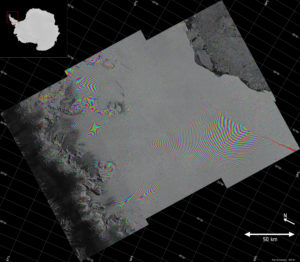Radar mission Sentinel-1 continues to monitor the growing crack in Antarctica’s Larsen-C ice shelf, which is expected to produce a massive iceberg
Two Sentinel-1 radar images from 7 and 14 April 2017 have been combined to reveal the growing crack in Antarctica’s Larsen-C ice shelf.
CPOM scientist Dr Anna Hogg said: “We can measure the iceberg crack propagation much more accurately when using the precise surface deformation information from an interferogram like this, rather than the amplitude – or black and white – image alone where the crack may not always be visible.”

Credit: Contains modified Copernicus Sentinel data (2017), processed by A. Hogg/CPOM/Priestley Centre, CC BY-SA 3.0 IGO Description
When the ice shelf calves this iceberg it will be one of the largest ever recorded – but exactly how long this will take is difficult to predict. The sensitivity of ice shelves to climate change has already been observed on the neighbouring Larsen-A and Larsen-B ice shelves, both of which collapsed catastrophically in 1995 and 2002 respectively.
These ice shelves are important because they act as buttresses, holding back the grounded ice that flows towards the sea, and contributes to present day sea level rise.
The Copernicus Sentinel-1 two-satellite constellation is indispensable for discovering and monitoring events like these because it delivers radar images every six days, even when Antarctica is shrouded in darkness for several months of the year.
CPOM is continuing to analyse Sentinel-1 data, distributing maps of ice velocity for key outlet glaciers of the Antarctic and Greenland ice sheets in near real time. The velocity maps are produced by tracking moving features in synthetic aperture radar data acquired by Sentinel-1.
